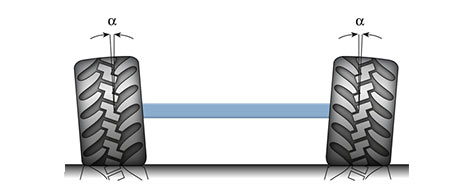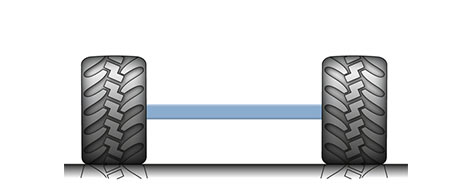Both the camber and toe-in of each BPW axle beam are set at the factory. These are minor values which have a big effect when driving. This is because the camber and toe-in protect tyres and provide more driving safety and efficiency.
Positive camber - unladen vehicle
Camber is defined as the angle (α) between the wheel centre plane and a line drawn perpendicular to the road surface. The camber is positive if the top of the wheel is angled outwards when the axle is unladen.
Positive camber – unladen vehicle
Positive camber - laden vehicle
The flexural load on the axle beam when the vehicle is laden causes the wheel to straighten. This means the tyre rolls with optimum road contact when the vehicle is laden, the most critical condition in terms of tyre wear. This avoids uneven, premature tyre wear.
Positive camber – laden vehicle
Toe-in
Toe-in is the angle (β), between the longitudinal axis of the vehicle and the wheel centre plane. Toe-in means the front part of the wheel is turned inwards towards the longitudinal axis of the vehicle – i.e. the distance between the front of the tyres (A) is less than the distance at the rear (B). When driving, the rolling resistance of the tyres causes the angle (β) to be reduced to zero, thereby guaranteeing good straight-line stability. Without toe-in, the wheels would attempt to run outwards.
Toe-in







